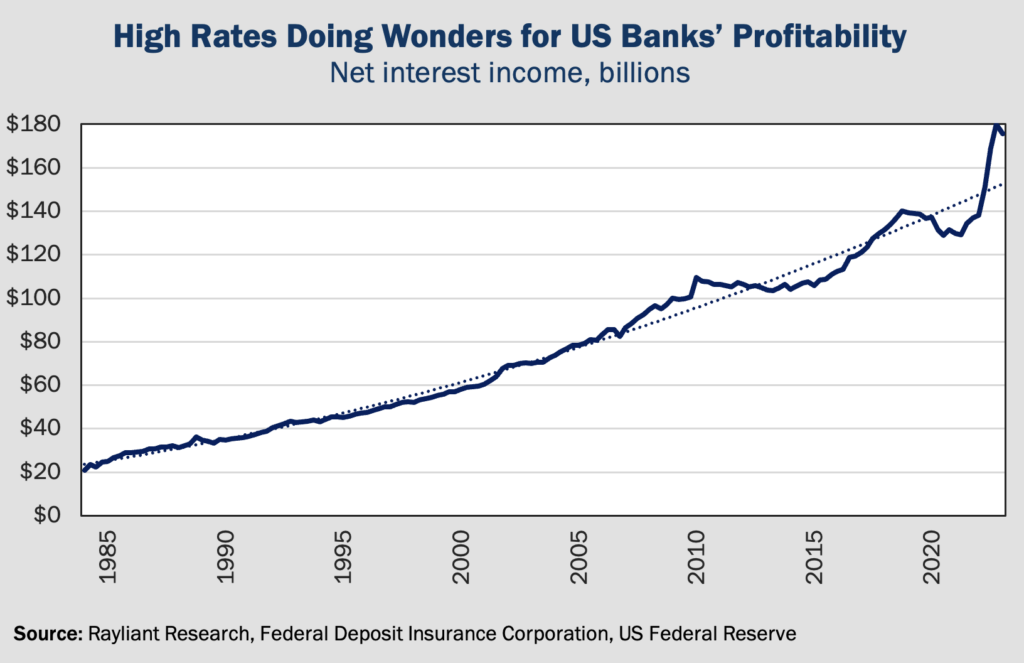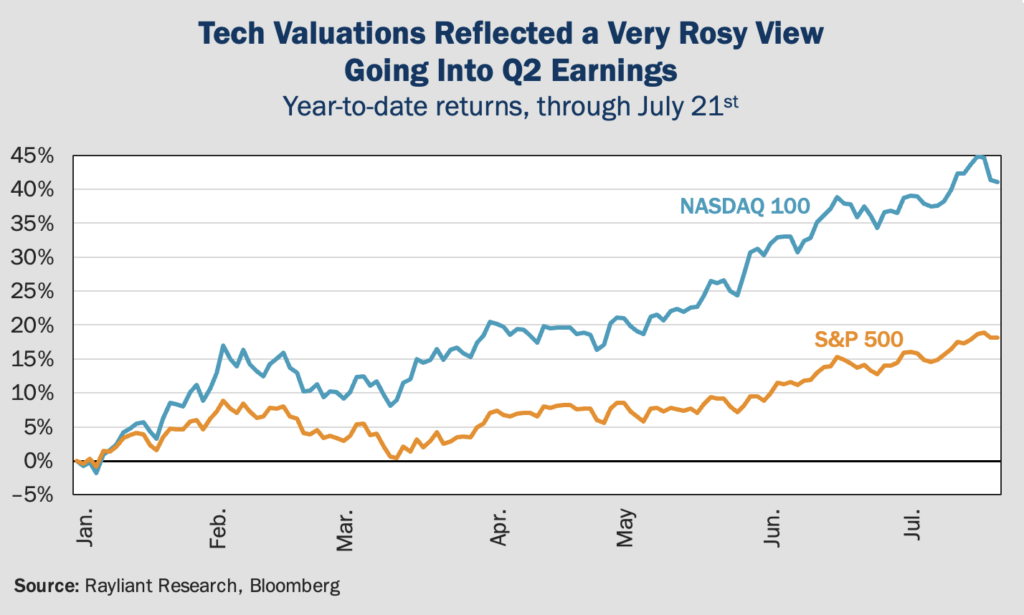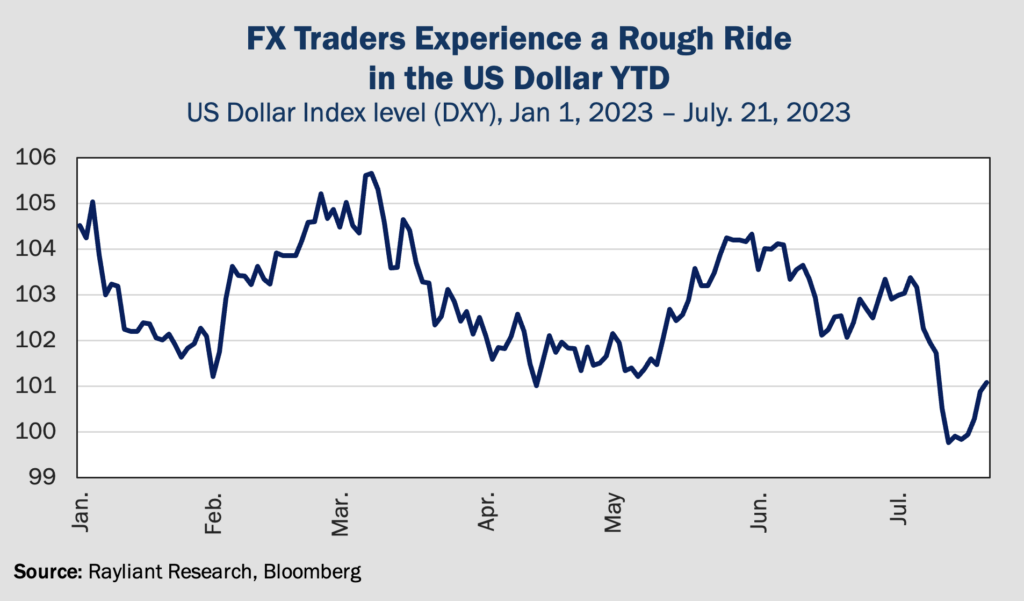
Fed tightening has given bank earnings a shot in the arm
We’re back in the heart of earnings season, and once again big banks kicked things off. Unlike many sectors we might expect to bemoan a hawkish Fed, banks typically get an earnings boost from higher rates: their net interest income rises, since they’re usually able to increase what they charge on loans faster than they have to raise the rate they pay to depositors for use of that capital. Data from the Federal Deposit Insurance Corporation (FDIC) show net interest income for US banks spiking after rate hikes beginning in the first quarter of 2022 (see below). Last quarter saw that trend continue, with Citigroup, JPMorgan Chase, and Wells Fargo posting net interest income totaling around $49 billion over the last three months, about 30% higher than what they brought in during Q2 last year. JPMorgan’s overall net income was 67% higher, year-over-year, while Wells Fargo, the nation’s fourth-largest lender saw profits increase more than 50% over the last twelve months. Investors were quite happy with surging profits from lending, with the S&P 500 Bank Index rising 5.4% since July 14th, when the first big financial firms reported results.

Investment bankers’ 2023 bonuses may be in jeopardy
Those of us looking through the headline numbers at more granular data and listening to bank execs’ outlook for the US economy would likely add some qualifications to the generally bullish assessment of bank earnings. For one thing, although a robust economy amidst high rates has driven profits in banks’ lending, not all lines of business in the financial sector have fared as well. Many firms showing an increase in net interest income saw investment banking fees fall precipitously as deal volume has slowed. Dealogic tracked second-quarter global M&A at just $732 billion, 36% lower than a year prior. Citi brought in just under $700 million from its investment banking services, down more than 30% since Q2 2022, while Goldman Sachs reported a 20% year-over-year decline in revenues for the segment.
Increasing reserves hint at increased risk of CRE defaults
Perhaps more disconcerting, given we’ve previously referenced commercial real estate (CRE) as a struggling sector of the property market to watch, were moves banks made with their loan loss provisions in Q2. In particular, we were interested to observe in reading last week’s 10-Qs how banks managed accounting allowances over the last quarter, which might shed light on their forecasts for potential losses in that space. The biggest CRE lenders bumped up reserves significantly since March, underscoring heightened likelihood for defaults, particularly in the office segment, with Wells Fargo increasing its allowance on losses for CRE loans from $2.7 billion to $3.6 billion since Q1, putting their reserves up nearly 64% since the beginning of this year.
Not all banks see a surge in profits, outlook mixed
We also note that while the biggest banks largely benefited from a ‘flight to quality’ as deposits fled weaker regional banks in the wake of March’s crisis in the sector, many smaller banks were forced to increase deposit rates in a bid to retain customers, weighing on profits. Even those money center banks reporting huge profits in Q2 warned against tougher times ahead, as institutional and corporate clients have started demanding higher rates on deposits. Meanwhile, a looming spending slowdown and expectations for slower loan growth in coming months are also risks for banks’ bottom line—and when America’s biggest banks raise concerns about the state of the economy, we pay attention.
Beyond banks, tech earnings looking like a letdown
Turning our focus to the tech sector, NASDAQ heavyweights Tesla and Netflix reported results last week, and you can judge the quality of those numbers by the market’s immediate reaction: TSLA sank by -9.74% post-announcement, it’s biggest one-day drop since April, while NFLX slid -8.41%, the stock’s biggest single-day decline since last December. Netflix had actually reported some pretty positive news: the company’s recent crackdown on password sharing saw subscriber growth hit 5.9 million over the last three months—way higher than last year’s second quarter, when the streamer saw almost a million users quit the service—pushing its earnings to $3.29 per share, a big beat versus the consensus forecast of $2.86 per share. Unfortunately, the company’s revenues missed expectations, and with tech valuations where they are today, even seemingly good results might not be quite enough to justify inflated share prices. Along those lines, it’s interesting to note that despite its post-earnings decline, NFLX was still up 45% YTD as of Friday’s close, trading at a forward price-to-sales ratio of nearly 6x, perhaps suggesting how little margin for error there is in a sector pricing so much optimism (see below).

Aggressive central bank policy drives turbulence in currencies
Currencies are another area of the markets seeing heightened action on last year’s tremendous shift in monetary policy, with volatility beginning to tick up again in recent weeks as we enter what feels like a decisive period for the world’s major central banks. The US dollar is a prime example, strengthening in February after a series of higher-than-expected inflation numbers prompted traders to price in more Fed hikes—increasing demand for dollars, which can be invested at more attractive US yields—only to weaken again in March and April after the collapse of several US regional banks gave investors hope the Fed might soon pivot to easing (see below).

Recent months have also witnessed outsized dispersion across markets, as economies’ prospects have varied significantly given different experiences with respect to geopolitics and economic implications of pandemic-era policy, with currencies like the UK pound sterling and Euro performing well against the dollar, while the Japanese yen and Chinese yuan showed significant weakness. That divergence makes things harder for speculators in FX markets.
Dollar outlook dims on expectations Fed nearly done
Speaking of which, we have recently observed major financial institutions—including JPMorgan, Morgan Stanley, HSBC, and Goldman Sachs—turning increasingly bearish on the US dollar, as surprisingly tame inflation once again prompted traders to bet the Fed is nearing peak hawkishness. Indeed, the US currency sank to a 15-month low against an index of other major currencies following June’s inflation report. That view is supported by more direct wagers on Fed policy, with the CME Group reporting that futures traders are currently pricing in a 99% likelihood that the US central bank raising rates by 25 bps at the end of July, though traders see only around 16% probability of another hike at the September FOMC.
What explains last week’s dollar rally?
Despite forecasts for future weakness, the dollar index rose 1.2% last week. One big driver of that move was the dollar-sterling pair, which ticked up on a softer-than-expected UK inflation reading; that news prompted traders to second guess their original expectation the Bank of England would lift rates by 50 bps at its August meeting (a 25 bps increase would do less to pump up demand for the pound). The dollar-yen pair also rose, as comments from Bank of Japan governor Kazuo Ueda indicated Japanese policymakers had no intention of dropping ultra-loose policy until there was a much more sustained increase in inflation toward the bank’s 2% target. The dollar appreciated against China’s yuan last week, as well, though that’s nothing new: USD/CNY is up over 4% so far this year, as the People’s Bank of China promotes easy policy amidst frustratingly weak macro conditions—though it’s notable that Chinese authorities have recently promoted tighter trading bands on the nation’s currency, signaling discomfort with the yuan’s weakness and suggesting the tide might soon turn for what Beijing hopes will eventually become a global reserve currency.
You are now leaving Rayliant.com
The following link may contain information concerning investments, products or other information.
PROCEED